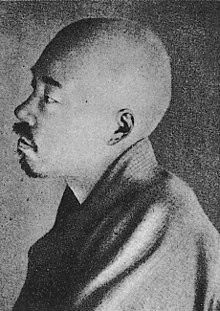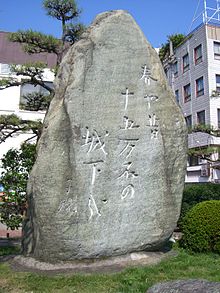Masaoka Shiki
Masaoka Shiki ( jap. 正岡子規 * 14. October 1867 in County Onsen , Iyo Province (now Matsuyama , Ehime Prefecture ); † 19th September 1902 in Tōkyō ) a Japanese poet, writer, literary critic and essayist was the Meiji period . His real name was Masaoka Tsunenori ( 正 岡 常規 ). In his childhood he was called Tokoronosuke ( 処 之 助 ) and later Noboru ( 升 ).
Masaoka was active in numerous literary disciplines and had a great influence on modern Japanese literature. He is the founder of modern haiku and tanka poetry and is counted among the four great haiku masters alongside Buson , Issa and Bashō . He founded the haiku magazine Hototogisu and paved the way for the later Tanka magazine Araragi .
He suffered from tuberculosis for the last seven years of his life and died at the age of 34.
His death is also in Japanese Hechimaki ( 糸瓜忌 , dt. " Sponge gourd -Trauertag"), named after the incurred shortly before his death death poem :
「糸 瓜 咲 て 痰 の つ ま り し 佛 か な.」
「Hechima sakite // tan no tsumarishi // hotoke kana.」
"The sponge gourd blooms and I become Buddha whose sputum took my breath away."
Another name for the day of death is Dassaiki ( 獺 祭 忌 ), after one of Shiki's stage names .
Life
Masaoka Shiki was born on October 14, 1867 in Onsen County (now Matsuyama ) in Iyo Province, the first son of Masaoka Tsunenao ( 正 岡 常 尚 ), a feudal man of Matsuyama- hans , and Masaoka Yaes ( 正 岡 八 重 ). The mother, Yae, was the eldest daughter of Ōhara Kanzan ( 大 原 観 山 ), a Confucian scholar of Hans. The father, Tsunenao, died in April 1872 when Masaoka Shiki was four years old. The following year, 1873, he attended the private school of his grandfather, Ōhara Kanzans, who taught him the (Japanese) reading of classical Chinese texts, and the Suehiro School , which was based on the model of an old temple school. In January 1875 he was transferred to the then Katsuyama School (today's Banchō Elementary School in Matsuyama).
In April the grandfather Ōhara Kanzan also died, whereupon he was further instructed in the classical Chinese scripts by Tsuchiya Kyūmei ( 土屋 久 明 ). In 1878 he wrote his first Chinese poem and received corrections from Kyūmei. He graduated from Katsuyama School in December 1879 and attended Matsuyama Middle School from March 1880 (today: Matsuyama Tōkō High School). In May 1883, however, he broke off middle school in the plan to take the exam to enter the university's preparatory school in Tōkyō. In October he prepared at the Suda and Kyōritsu School for an examination in English and from September 1884 attended the Daigaku-yobimon School ( 大学 予 備 門 , Daigaku-yobimon ), the preparatory school of the Tōkyō University , which during this time in the first middle and high school ( 第一 高等 中 学校 , Dai-ichi kōtō chūgakkō ) was converted. His classmates included Natsume Sōseki , Yamada Bimyō , Ozaki Kōyō and Teraishi Masaji . It was around this time that he began to write haiku . In July 1888 he finished the preparatory course of the first middle and high school and began the regular school education. In May 1889, he had the coughing up blood and then used for the first time the stage name Shiki , a Sino coined word for the " lesser cuckoo " of which is said to sing until he spits blood.
In July 1890 he finished the first middle and high school and enrolled at the philosophical faculty of the University of Tōkyō, soon afterwards, in January 1891, switched to Japanese studies and instructed Kawahigashi Hekigotō and Takahama Kyoshi in the haiku poetry. In 1892 he published Dassai-Shooku-Haiwa ( 獺 祭 書屋 俳 話 ) and advocated the renewal of haiku as an independent form of literature. In October of the same year, however, he dropped out and started working for the Nippon Shimbun newspaper.
In 1894 he moved to the community of Kaminegishi ( 上 根 岸 町 , -chō ) in the former Tōkyōter district of Shitaya ( 下 谷 区 , -ku ), now part of the Taitō district . He called his place of residence there Shikian ( 子規 庵 , dt. "Shiki hut").
In the First Sino-Japanese War , he worked as a correspondent for the Japanese military in Lüshun from April 1895 . During the drive home, he coughed up blood again and needed treatment.
His style of haiku was recognized, and in October he published Haikai-taiyō ( 俳 諧 大 要 , "The most important thing about haiku"). In January 1897 he founded the magazine Hototogisu in Matsuyama , which, like his pseudonym, means "gackle cuckoo". In that year his lung disease was joined by a tubercular disease of the spine .
In April 1897 he published Haijin Buson ( 俳 人 蕪 村 , "The Haiku Poet Buson "). In February 1898, Utayomi ni atauru sho ( 歌 よ み に 与 ふ る 書 , "writing dedicated to poets") followed as a work , through which he began to devote himself to a redesign of the Waka . In March he called the Negishi Tanka community together in his home . He also advocated the description of nature , in which he himself became active as a literary genre in 1899 and thus also entered the field of prose literature. In 1900 he organized a reading group on Man'yōshū and was attended by Nagatsuka Takashi and Itō Sachio . In January 1901 he published Bokujū-itteki ( 墨汁 一滴 , "A drop of ink") and in September Gyōga-manroku ( 仰臥 漫 録 , roughly: "The sketches of a reclining person "). In 1902 he wrote, already in the critical final stage of his illness, Byōshō-rokushaku ( 病牀 六尺 , "The six feet of the sickbed"). On September 19 of this year, Masaoka Shiki finally passed away.
Pseudonyms
The actual name was Masaoka Tsunenori ( 正 岡 常規 ). Shiki is the most common of the pseudonyms. But countless other pseudonyms have also been documented. Takizawa Bakin has 35 names, including posthumous names. In fact, there were many more. Shiki himself lists more than a hundred in his work Fudemakase ( 筆 ま か せ , for example: "I hand it over to the writing brush").
In his childhood Shiki was first called Tokoronosuke ( 處 之 助 ). When he reached school age at around five, his grandfather, Ōhara Kanzan , gave him the shorter name Noboru ( 升 ) so that other children wouldn't tease him about the name. His mother and friends then affectionately called him Nobo-san ( の ぼ さ ん ). The names Tokoronosuke , Noboru , Shiki , Dassai-shooku-shujin and Take no Satobito are recorded in his epitaph .
The name Dassai-shooku-shujin ( 獺 祭 書屋 主人 , "lord of the Otterfest writing room") goes back to the fact that Shiki called his own room Dassai-shooku (literally: "Otterfest writing room "), after the natural phenomenon that the otter does not eat caught fish immediately, but rather lays them next to each other on the river bank or on a rock. In ancient China, this was seen as a parallel to offerings that were made on a (religious) festival and therefore spoke of an "otter festival". This later gave rise to a saying that was used when books were laid out for work in a poet's room. This pseudonym is the reason why the day of Shiki's death, September 19, is also known as Dassaiki ("Dassai day of mourning", "day of mourning of the otter").
The name Take no Satobito ( 竹 ノ 里人 , "The bamboo villager") goes back to the fact that the place where Shiki lived in Tōkyō was called Kuretake no negishi no sato ( 呉 竹 の 根 岸 の 里 ).
He used the name Shiki ( 子規 , "Gackelkuckuck") from 1889, the year when he coughed up blood for the first time. The connection consists in the idea that the cuckoo-cuckoo, when it sings in a high-pitched voice, showing its red tongue, looks as if it were "spitting out blood". But the fact that the first poem Shiki himself wrote in Kambun was entitled Hototogisu o kiku ( 聞 子規 ), where hototogisu and shiki are two readings for the same word, may also be related to the choice of the pseudonym.
At the age of 22, Shiki adopted the name Sōseki as a haiku poet , at the same time that Natsume Sōseki , who was actually called Kinnosuke , also chose the name. The name was then given to Sōseki by Shiki. In Fudemakase Shiki writes: "Sōseki has now become my friend's pseudonym."
baseball
Shiki was an avid baseball player when the sport was first introduced to Japan and stayed with it until he was forced to quit in 1889 due to coughing up blood. Until then, he played in the position of catcher . Since the name he had in his childhood was Noboru , he chose the pseudonym Nobōru ( 野球 ) for himself , which expressed his joy in the sport. ( Bōru is a Japanese form of the English word for “ball,” no is the Japanese word for “field,” reminding us that baseball is played on a field. The characters Shiki used to represent his pseudonym were later used by Chūman Kanae is used as the Japanese translation word for the English “baseball”, but with the completely different reading yakyū , which is the common Japanese word for “baseball.” Nevertheless, Shiki was the one who used the characters first and also for many others with the sport related words coined Japanese terms.) Shiki continued to write poems on baseball, and thus contributed literarily to the spread of the sport that is now very popular in Japan. In recognition of the foregoing, Shiki was inducted into the Japanese Baseball Hall of Fame in 2002.
In popular culture
Masaoka Shiki is one of the protagonists in Shiba Ryōtarō's novel Saka no Ue no Kumo , which was published in eight volumes from 1968 to 1972 . In the television series of the same name (2009-2011) based on the book, the actor Teruyuki Kagawa took over his role.
Works in German translation
- Masaoka Shiki: I'll go . Bilingual edition: Japanese / German. German adaptation: Fumie Miyata; Illustrations and cover: Ando Ueno. Calambac Verlag, Saarbrücken 2018, ISBN 978-3-943117-01-1 .
Web links
- Short biography and pictures (Japanese)
- Extensive personal information (Japanese)
- Digitized works at Aozora Bunko (Japanese)
- Haiku in German translation
Individual evidence
- ↑ Article about the pseudonyms Masaoka Shikis ( Memento of the original from October 24, 2007 in the Internet Archive ) Info: The archive link was inserted automatically and has not yet been checked. Please check the original and archive link according to the instructions and then remove this notice.
- ↑ Masaoka's entry at the Japanese Baseball Hall of Fame
| personal data | |
|---|---|
| SURNAME | Masaoka, Shiki |
| ALTERNATIVE NAMES | 正 岡 子規 (Japanese); 正 岡 常規 (Japanese, maiden name); Masaoka Tsunenori; 正 岡 処 之 助 (Japanese); Masaoka Tokoronosuke; 正 岡 升 (Japanese); Masaoka Noboru |
| BRIEF DESCRIPTION | Japanese writer |
| DATE OF BIRTH | October 14, 1867 |
| PLACE OF BIRTH | County Onsen , Iyo Province (now Matsuyama , Ehime Prefecture ) |
| DATE OF DEATH | September 19, 1902 |
| Place of death | Tokyo |


